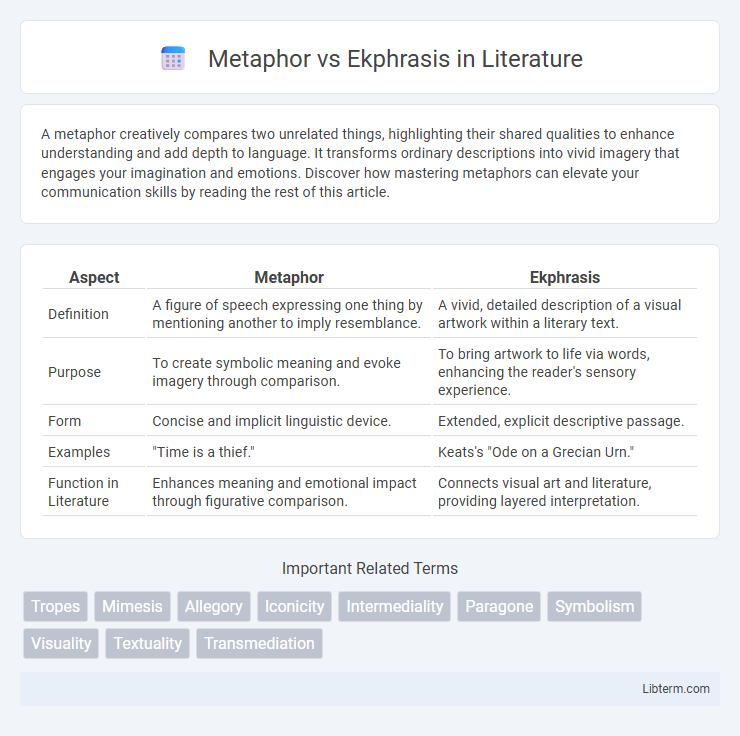A metaphor creatively compares two unrelated things, highlighting their shared qualities to enhance understanding and add depth to language. It transforms ordinary descriptions into vivid imagery that engages your imagination and emotions. Discover how mastering metaphors can elevate your communication skills by reading the rest of this article.
Table of Comparison
| Aspect | Metaphor | Ekphrasis |
|---|---|---|
| Definition | A figure of speech expressing one thing by mentioning another to imply resemblance. | A vivid, detailed description of a visual artwork within a literary text. |
| Purpose | To create symbolic meaning and evoke imagery through comparison. | To bring artwork to life via words, enhancing the reader's sensory experience. |
| Form | Concise and implicit linguistic device. | Extended, explicit descriptive passage. |
| Examples | "Time is a thief." | Keats's "Ode on a Grecian Urn." |
| Function in Literature | Enhances meaning and emotional impact through figurative comparison. | Connects visual art and literature, providing layered interpretation. |
Introduction to Metaphor and Ekphrasis
Metaphor is a fundamental figure of speech in literature that creates meaning by directly equating one thing to another, enriching language with symbolic significance. Ekphrasis refers to a vivid, often dramatic, verbal description of a visual artwork, aiming to capture and evoke the essence of the original piece. Both devices engage readers' imaginations but differ in function: metaphor abstracts and transforms meaning, while ekphrasis concretizes and visualizes artistic experience.
Defining Metaphor: Meaning and Usage
Metaphor is a linguistic device that involves describing one thing by directly relating it to another, highlighting shared qualities to create meaning beyond the literal. It functions as a fundamental mechanism in both poetry and everyday language, enabling nuanced expression and cognitive connections. Unlike ekphrasis, which vividly describes visual art, metaphor operates through conceptual substitution to deepen understanding and emotional impact.
What is Ekphrasis? Origins and Evolution
Ekphrasis is a vivid, detailed description of a work of art within a literary text, originating from the Greek word "ekphrazein," meaning "to proclaim" or "describe." Its origins trace back to ancient Greek literature, where poets like Homer used ekphrasis to bring visual art to life through words, exemplified in the detailed shield of Achilles in the Iliad. Over time, ekphrasis evolved beyond poetry into various literary forms, serving as a bridge between visual and verbal expression that enhances the reader's sensory experience.
Historical Context: Metaphor vs Ekphrasis in Literature
Metaphor, rooted in ancient rhetoric, has been a fundamental literary device since classical antiquity, used extensively in Greek and Roman poetry to convey symbolic meanings beyond the literal. Ekphrasis, originating in the same era, specifically offers vivid, often elaborate descriptions of visual art within a literary work, blending visual and verbal artistry to create immersive experiences. While metaphor abstracts and condenses meaning, ekphrasis historically functions as a bridge between artistic forms, enriching texts by invoking the presence of physical artworks.
Structural Differences Between Metaphor and Ekphrasis
Metaphor functions structurally as a linguistic device that directly compares one concept to another, embedding symbolic meaning within a compact phrase or sentence. Ekphrasis, by contrast, structurally extends into a detailed, often vivid description of a visual artwork, aiming to translate visual elements into verbal expression. While metaphor condenses meaning through implicit comparison, ekphrasis unfolds a narrative or sensory experience driven by explicit depiction and literary expansion.
Functions of Metaphor in Language and Art
Metaphor functions as a cognitive tool that enables abstract thinking by linking unfamiliar concepts to familiar experiences, enriching both language and art with deeper layers of meaning. In literature and visual art, metaphors create symbolic connections that evoke emotions and provoke reflection beyond literal representation. This semantic device enhances understanding by transforming perception and facilitating the communication of complex ideas through imagery and analogy.
The Role of Ekphrasis in Visual and Literary Arts
Ekphrasis serves a pivotal role in both visual and literary arts by transforming visual imagery into vivid, descriptive language that deepens the audience's engagement and understanding of the artwork. Unlike metaphors, which rely on symbolic comparisons to convey abstract ideas, ekphrasis provides a detailed, sensory experience that bridges the gap between visual perception and verbal expression. This technique enriches literary works by invoking detailed art representations, fostering an immersive connection between the reader and the visual culture.
Examples: Metaphor and Ekphrasis in Classic Works
Metaphor, as seen in Shakespeare's "Juliet is the sun," uses direct symbolic language to convey abstract ideas through vivid comparisons. Ekphrasis appears in Homer's "Iliad" when the Shield of Achilles is described in elaborate detail, bringing an artwork to life through poetic imagery. Classic literature demonstrates metaphor's conceptual expression and ekphrasis's descriptive power, enriching readers' imaginative experience.
Impact on Reader Interpretation and Engagement
Metaphor enhances reader interpretation by creating abstract connections that evoke personal insights and emotional responses, fostering deeper conceptual engagement. Ekphrasis anchors interpretation in vivid sensory detail, provoking visual imagination and making the described artwork accessible within the text's context. Both techniques shape reader engagement uniquely, with metaphor prompting introspective meaning-making and ekphrasis offering immersive, tangible imagery that stimulates experiential understanding.
Conclusion: Choosing Between Metaphor and Ekphrasis
Selecting between metaphor and ekphrasis depends on the desired depth of sensory engagement and interpretive layering in the narrative. Metaphors offer concise conceptual insights by relating one idea to another, fostering abstract connections, whereas ekphrasis provides vivid, detailed descriptions of visual art to evoke immersive imagery and emotional resonance. Writers aiming for immediacy and symbolic meaning may prefer metaphor, while those seeking to create rich, visual storytelling often choose ekphrasis for its ability to animate art through language.
Metaphor Infographic

 libterm.com
libterm.com